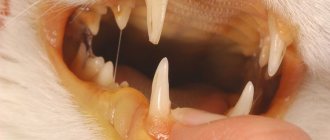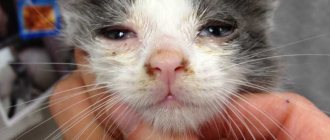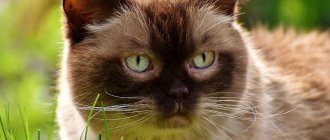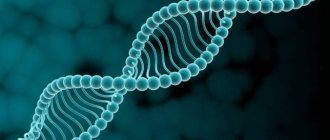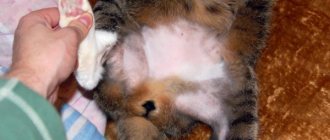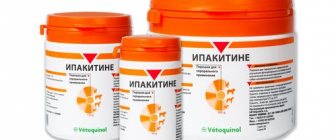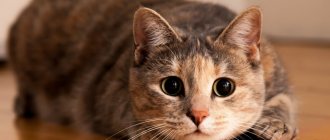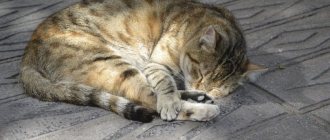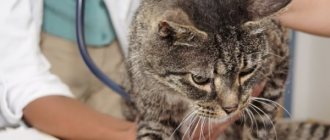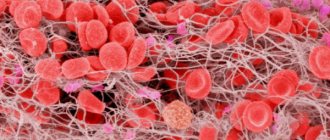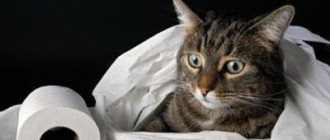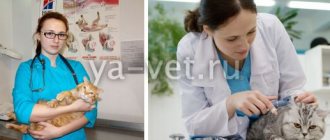The situation when stray and “semi-domesticated” cats’ eyes do not shine with health is common. Keratitis and conjunctivitis, injuries and parasites - all this leads to the fact that they are covered with a crust of dried exudate. If the animal is always at home, it is not immune from eye problems. A clear confirmation of this is the turn of the century. In cats, this pathology is diagnosed much less often than in the case of dogs, but this also happens.
Entropion (entropion) in cats
Entropion of the eyelids or entropion of the eyelids in cats is a pathology that is characteristic not only of horses, dogs and other species of animals, but also occurs in cats; the disease is characterized by an inversion of the palpebral edge with an area of skin and hair of the eyelids towards the eye. With each act of blinking, the folded structures exert friction on the cornea of the eye. Entropion in cats usually affects the entire length of the lower eyelid, but one or two thirds of the eyelid may also be involved.
The degree of inversion of the eyelids in cats can vary. When the eyelid is rotated 45 degrees relative to the cornea, no serious problems occur. Rotation of approximately 90 degrees can lead to the development of epiphora, vascularization and corneal erosions. And finally, when turning 180 degrees, serious pathological changes occur, including: corneal trauma, the formation of erosions and ulcers, ingrowth of blood vessels (vascularization), pigment deposition in the cornea, the development of lacrimation, the appearance of mucopurulent discharge and blepharospasm. In addition, in cats that are sick with herpes viral infection type 1 (FelineHerpesVirustype-1, FHV-1), prolonged traumatic effects on the cornea of the skin and hair of the folded eyelids provoke the development of a serious disease - stromal sequestration of the cornea. The listed pathological processes significantly reduce vision, cause discomfort and pain, and can lead to the loss of not only vision, but the eye as an organ, especially with the development of sequestration and corneal ulcers with perforation, reactive inflammation of the choroid (uveitis). Sick cats have a decreased appetite, they lose weight, and become apathetic.
Functions of the membrane
A cat has a thin, almost transparent film in its eye, which is located in the inner corner. It is called the nictitating membrane. It moisturizes the cornea, serves as a barrier to foreign bodies and microparticles, and also rids the eye of small insects, sand and household dust. This membrane is covered with lymphoid tissue, attached to the inside of the lower and upper eyelids and floats slightly onto the cornea.
We invite you to familiarize yourself with: Character and distinctive features of the Burmese cat breed
This membrane involuntarily expands and folds, this is noticeable during blinking and when the pet lowers its head. If the eye is irritated, the film swells and increases in size. The membrane lubricates the cornea with a special tear fluid, which protects the eye from bacterial environments and fungal infections.
Causes of entropion in cats
The etiology of the process in most cases is genetic; more often the disease affects Maine Coon, British, Scottish and Persian cats, and can also occur in other breeds. Among other causes of entropion, there is secondary or acquired entropion, which develops against the background of corneal pain due to its lesions (erosions, corneal ulcers). Entropion with subatrophy of the eyeball or microphthalmos, as a result of these pathological conditions, the eyelids roll up without finding support in the form of the eyeball. In clinical practice, entropion occurs as a result of injuries, burns of the eyelids, with a violation of their correct anatomical configuration, but such conditions are much less common than others.
Videos and illustrations
Inversion century Maine Coon cats. Entropion in a Maine Coon cat 2017
Entropion of the eyelids in a Maine Coon
Entropion of the eyelid in the Maycoon breed
Inversion of the lower eyelid and its plastic
Scheme of surgery for kittens using the mattress suture technique
( 1 rating, average 5 out of 5 )
Treatment of entropion in cats
Treatment includes both medical and surgical methods.
Therapeutic methods include the use of gels and ointments, which have a protective and lubricating effect, as a result of which the friction of the skin and hair of the folded eyelids on the cornea is significantly reduced. Therapeutic treatment may be used for cats with mild entropion (at 45 degrees). In other cases, especially if there are serious lesions of the cornea as a result of friction or herpes viral keratitis, the use of lubricants and ointments is necessary only until surgical correction of the eyelid position (blepharoplasty).
Entropion of the eyelids in cats - surgery
Surgical treatment of entropion in cats (blepharoplasty) is the method of choice for entropion of 180 degrees, in some cases with entropion of 90 degrees, with concomitant herpes viral infection type 1 cats, as a measure to prevent the development of corneal sequestration. There are quite a few methods for the surgical treatment of entropion in different animal species; for cats, the main method is Hot-Cels blepharoplasty, sometimes modified depending on the specific clinical case.
When performing this technique, the first incision begins at a distance of 2-2.5 mm from the edge of the eyelid and parallel to it, the second arcuate incision connecting the two ends of the first incision is made after assessing the area of skin that is wrapped. The edges of the wound are sutured with a non-absorbable monofilament thread of small sizes (no more than 5/0) with interrupted sutures at intervals of no more than 2 mm. Working with suture material of this size requires the use of optical magnification (surgical loupe, operating microscope). The sutures are removed within 10-14 days; during this period the cat must be in a protective collar to ensure the safety of the sutures.
Blepharoplasty does not cure genetic diseases, and when breeding cats with entropion of the eyelids, the disease will be transmitted to the offspring, so affected cats should be excluded from breeding.
Predictions for postoperative outcome
In the vast majority of cases, the prognosis for cats is quite favorable. However, several factors influence a successful outcome: the animal’s age, breed, tendency to relapse, and general health. Careful care after surgery is essential. To prevent scratching of the wound, the cat is given a special collar.
If the animal scratches its eyes, the problem may recur, and then you will have to go to the clinic again. Sutures should be regularly treated with special solutions prescribed by the attending physician. With proper care and successful healing, the sutures can be removed 10 days after the operation, and the cat will begin its full life again.
Thus, we can conclude that entropion of the eyelid in a cat is a completely solvable problem that can be easily treated, without which the condition of your beloved pet can greatly worsen, as a result of which he can completely lose his vision. Therefore, you should not delay with this problem, but immediately contact a veterinary clinic.
Entropion of the eyelid in a cat: main symptoms and treatment of the disease
The situation when stray and “semi-domesticated” cats’ eyes do not shine with health is common. Keratitis and conjunctivitis, injuries and parasites - all this leads to the fact that they are covered with a crust of dried exudate. If the animal is always at home, it is not immune from eye problems. A clear confirmation of this is the turn of the century. In cats, this pathology is diagnosed much less often than in the case of dogs, but this also happens.
Good to know
- Plague in cats (diagnosis, treatment, vaccination). How to avoid infecting your pet with feline distemper?
- Feline panleukopenia (etiology, therapy). What to do after panleukopenia?
- Viral Leukemia in Cats (Symptoms, Diagnosis, Treatment, Prevention, Vaccine, Tests for Leukemia in Cats)
- Leptospirosis in cats (etiology, pathogenesis, symptoms, diagnosis, treatment and prevention). Vaccination for leptospirosis
- Viral leukemia in cats (symptoms and treatment). How to help a cat?
- Hemobartonellosis in cats and dogs (epizootology, pathogenesis, diagnosis and treatment). Biological properties of Mycoplasma Haemofelis. Control and prevention measures for hemobartonellosis in cats
- Borreliosis in animals and humans (etiology, diagnosis, spread, causes, therapy, signs and symptoms, prevention). Lyme disease in dogs
- FLV in cats (epizootology, diagnosis and treatment) FeLV for cats (causes, vaccination, prevention and therapy)
- Viral leukemia of cats (etiology, diagnosis, therapy, prevention). What to do if my cat is sick with the leukemia virus
What it is?
Entropion of the eyelid is a pathology when this skin fold, as a result of weakening of its ligamentous apparatus, turns inward. As a result, the hair and eyelashes are in direct contact with the cornea of the eye. The volvulus can be mild, and then the animal feels only mild discomfort, and the presence of pathology can only be guessed due to increased lacrimation from the eye. But more often, the disease is much more serious, and as a result, the cat can easily find itself not only without vision, but also without an eyeball. What are the causes of entropion in cats?
The disease is divided into primary and secondary. Primary volvulus , as is easy to understand, is a congenital pathology that manifests itself even in newborn kittens. Secondary volvulus is an acquired disease. It is believed that bloat in cats is most often unilateral. Finally, inversion of the lower eyelid in a cat is much more typical than damage to the upper eyelid.
In the case of cats, this pathology is not so often hereditary. It is often caused by injuries and inflammatory diseases of the eyes. Be that as it may, bloat should be treated immediately. If you are late with this, you will almost certainly have to deal with chronic keratitis, or, better yet, conjunctivitis.
In cats, inversion of the eyelids demonstrates a pronounced “attachment” to certain breeds . Most likely, this is due to some kind of recessive gene, since the disease does not always manifest itself. In 80% of cases, entropion of the eyelids occurs in Persian cats, their crosses, Himalayan, British and Scottish breeds of cats. In other words, brachycephalics. It should be noted that the point here is, rather, not so much in hereditary predisposition as in the physiological characteristics of these animals.
Etiological features of the pathology
Specialists from the Center for Veterinary Ophthalmology of Dr. A.G. Shilkin clarify that entropion of the eyelids is more often diagnosed in Sphynxes, Maine Coons, Britons, Persians, exotics and Himalayan cats. Veterinarians identify several reasons for the development of the disease:
- Genetics. Risks are determined by the presence of a recessive gene.
- Developmental anomalies. If the size and shape of the eyelid is non-standard, for example, smaller or longer than the eyeball, then entropion occurs more often.
- Injuries. The pathology develops against the background of damage to the eye, contact with the mucous membrane of a foreign body. If a cat has a chemical or thermal burn, and the affected area is healed, or scars remain after a severe dermatological disease, entropion of the eyelid also occurs.
- Muscle disorders. The twist may be the result of spasms or contraction of the orbital muscles, paralysis of the facial nerve with the development of muscle atony.
- Operations. Problems with the eyelid are possible after unsuccessful surgery.
- Age-related changes. In old cats, the skin loses tone, the muscles weaken, the eyelids sag and entropion occurs.
- Other pathologies. Neoplasms of a benign or malignant nature also provoke a hemorrhage.
This pathology can develop in the third eyelid of the animal.
Experts distinguish entropion of primary and secondary types. The first occurs in kittens due to genetic predisposition, abnormalities in muscle development or the fold itself. The second develops against the background of injuries, ophthalmic pathologies or age-related changes. Entropion of the lower eyelid occurs more often than problems with the upper eyelid.
Basic information
Most cases of primary entropion of the eyelids occur in very young cats, who have just turned six months old. As a rule, a sick animal can only be cured with timely surgery. But in some cases, volvulus goes away spontaneously, without any medical intervention. But this only applies to young cats. It is important to understand that even in relatively severe cases you will still have to wait until at least four months of age to have surgery.
Trauma, chronic inflammation, and many eye diseases can lead to secondary entropion. This happens most often in cats (as we have already discussed). Many owners take the animal to the veterinarian, who corrects the eyelid, but the problem appears again. The fact is that simultaneously with the entropion of the eyelid, it is necessary to cure the disease due to which the pathology developed.
Diagnostics
Identifying a bloat is not that difficult. Just a careful examination of the cat's eye itself is enough. The doctor will observe swelling, copious tear discharge, and the mechanical volvulus itself.
If surgical intervention is planned, then a general examination is mandatory, to determine the cat’s health status - a general and biochemical blood test, a urine test, an ultrasound of the abdominal organs and an ECG.
In case of a complicated course, an ulcer and other damage to the cornea should be diagnosed. To do this, the eye is examined under the rays of a slit paw after instillation of a fluorescent substance.
If an infection is suspected, a bacterial culture should be performed to select antibiotics.
Symptoms
How can you tell if your pet needs an urgent visit to the vet? In the initial stages, the cat often begins to “wink” at the owner and avoids looking at light sources. Tears flow profusely from her eyes, and soon the discharge becomes mucous and quite thick. The animal acquires the habit of looking sideways at the world around it. In many cases, the eyelids themselves become inflamed and swollen, and the tissues of the organ become noticeably hot to the touch.
Intolerance to light reaches a peak stage; the animal cannot look at lamps or the sun at all. It begins to constantly rub its eyes with its paws, and this causes it severe pain. If you notice these symptoms in your pet, we advise you to contact your veterinarian immediately.
